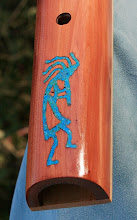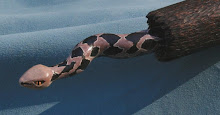A little flute philosophy...
Each of my 'kids' has had all 4 elements put into them: earth, water, fire, air. While it may seem like no big deal, I like to think it's kind of neat. Those of us in love with the Native American flute appreciate it's spiritual roots, and almost all of us sense that each one has its own spirit. Once I began making flutes, I quickly realized just how much spiritual energy is in each piece of wood. To that effect, I refer to flutes/woods as 'talking to me' as I'll get these constant intuitive 'gut' calls to do something one way or the other, or choose this key or that key, or make it with this motif or that...it is most interesting. Oh yes, there have been those flutes that sit for months and give me the message of 'don't touch me right now!', so I expect nothing so I can be ready for anything.
I begin with 'earth' in terms of the wood. I use 'fire' in the form of a burning tool that I do all of my sound holes and flues with, as well as tapping finger holes. Take off the block and you'll see signs of the fire used...once I get that perfect sound quality I'm looking for, I quit filing, leaving the marks where they are. What's really neat is that as I burn openings, then stop and file away the charcoal, then burn some more, I hold the flute up at an angle and blow to send the smoke on its way (away from my eyes!)...so here you have these early flutes with thick coils of smoke going through the entire flute, as if smudging it clean. I use stones to finish out the finger holes, so more 'earth' involved.
As I sand the flute down (and sand, and sand, and sand!) I stop at the 320-grit stage and sponge a light coating of 'water' over the flute. You don't want to soak it, of course, just lightly wipe it on and shake off the excess. I put it on a dowel rack to dry...very important step, this one. The water 'pops' the grain...320 is smooooth, and after the water it's 'rough' again. When you sand at 320 again, the surface starts to feel like glass...and as you move to higher and higher grits, it's more glass-like. This is especially important when using woods with a lot of curl and figuring in them, which I will hand sand down to 1000-1200 grit.
There is the voicing which is the 'air' part, of course...and outside of creating a honey-dripping voice in a flute, my favorite part is when I put on an oil coat after all that sanding. WOW! There's nothing like that instant rush of beauty. I'll detail particular fluids I use in a later post.
And so when a flute is done, it's the 'earth' to begin with that has fire, water, and air run through it. The player adds their spirit to it and, voila, sweet music goes out into this world. And we can never have too much of that, eh?
Blessed be.
Each of my 'kids' has had all 4 elements put into them: earth, water, fire, air. While it may seem like no big deal, I like to think it's kind of neat. Those of us in love with the Native American flute appreciate it's spiritual roots, and almost all of us sense that each one has its own spirit. Once I began making flutes, I quickly realized just how much spiritual energy is in each piece of wood. To that effect, I refer to flutes/woods as 'talking to me' as I'll get these constant intuitive 'gut' calls to do something one way or the other, or choose this key or that key, or make it with this motif or that...it is most interesting. Oh yes, there have been those flutes that sit for months and give me the message of 'don't touch me right now!', so I expect nothing so I can be ready for anything.
I begin with 'earth' in terms of the wood. I use 'fire' in the form of a burning tool that I do all of my sound holes and flues with, as well as tapping finger holes. Take off the block and you'll see signs of the fire used...once I get that perfect sound quality I'm looking for, I quit filing, leaving the marks where they are. What's really neat is that as I burn openings, then stop and file away the charcoal, then burn some more, I hold the flute up at an angle and blow to send the smoke on its way (away from my eyes!)...so here you have these early flutes with thick coils of smoke going through the entire flute, as if smudging it clean. I use stones to finish out the finger holes, so more 'earth' involved.
As I sand the flute down (and sand, and sand, and sand!) I stop at the 320-grit stage and sponge a light coating of 'water' over the flute. You don't want to soak it, of course, just lightly wipe it on and shake off the excess. I put it on a dowel rack to dry...very important step, this one. The water 'pops' the grain...320 is smooooth, and after the water it's 'rough' again. When you sand at 320 again, the surface starts to feel like glass...and as you move to higher and higher grits, it's more glass-like. This is especially important when using woods with a lot of curl and figuring in them, which I will hand sand down to 1000-1200 grit.
There is the voicing which is the 'air' part, of course...and outside of creating a honey-dripping voice in a flute, my favorite part is when I put on an oil coat after all that sanding. WOW! There's nothing like that instant rush of beauty. I'll detail particular fluids I use in a later post.
And so when a flute is done, it's the 'earth' to begin with that has fire, water, and air run through it. The player adds their spirit to it and, voila, sweet music goes out into this world. And we can never have too much of that, eh?
Blessed be.





No comments:
Post a Comment